Each January the Notable Books for a Global Society Committee of the Children’s Literature and Reading Special Interest Group (CL/R SIG) selects 25 books published in the previous year that illustrate diversity in its many forms. This column is the first of two introducing the 2019 Notable Books for a Global Society list for pre-K–12 students. More information about Notable Books for a Global Society (including lists of previous winners) is available at clrsig.org.
Ages 4–8
All Are Welcome. Alexandra Penfold. Ill. Suzanne Kaufman. 2018. Knopf/Random House.
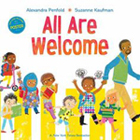 “Pencils sharpened in their case. / Bells are ringing, let’s make haste. / School’s beginning, dreams to chase. / All are welcome here.” School is a place where all children of different races, religions, and backgrounds are welcome and where they learn and grow together. Lively, brightly hued double-page spreads express the children’s joyous daily activities. In depicting parents as diverse as the children, Penfold and Kaufman share a message about celebrating diversity and inclusion. “We’re part of a community. / Our strength is our diversity. / A shelter from adversity. / All are welcome here.”
“Pencils sharpened in their case. / Bells are ringing, let’s make haste. / School’s beginning, dreams to chase. / All are welcome here.” School is a place where all children of different races, religions, and backgrounds are welcome and where they learn and grow together. Lively, brightly hued double-page spreads express the children’s joyous daily activities. In depicting parents as diverse as the children, Penfold and Kaufman share a message about celebrating diversity and inclusion. “We’re part of a community. / Our strength is our diversity. / A shelter from adversity. / All are welcome here.”
—JS
The Day War Came. Nicola Davies. Ill. Rebecca Cobb. 2018. Candlewick.
 While at school one day, a little girl survives bombs that destroy her school and discovers her home is also destroyed and her family killed. An orphan, she flees the unnamed country on a perilous journey with many other people and eventually finds safety in a refugee camp. When she is turned away from an overcrowded school because there is no place for her to sit, a child brings her a chair at the camp so that she can return to school. This story, depicted in delicate graphite, colored pencil, and watercolor illustrations, conveys the plight of refugee children and shows how kindness and generosity can surmount political and social limitations. Back matter includes background information on programs to aid refugees.
While at school one day, a little girl survives bombs that destroy her school and discovers her home is also destroyed and her family killed. An orphan, she flees the unnamed country on a perilous journey with many other people and eventually finds safety in a refugee camp. When she is turned away from an overcrowded school because there is no place for her to sit, a child brings her a chair at the camp so that she can return to school. This story, depicted in delicate graphite, colored pencil, and watercolor illustrations, conveys the plight of refugee children and shows how kindness and generosity can surmount political and social limitations. Back matter includes background information on programs to aid refugees.
—SW
Drawn Together. Minh Lê. Ill. Dan Santat. 2018. Disney-Hyperion.
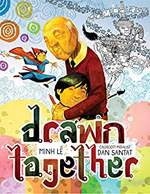 A young boy visiting his grandfather speaks English; his grandfather speaks Thai. They struggle to communicate across language, age, and cultural divides, leading to confusion and uncomfortable silence, but when the boy takes out his sketchbook and markers and begins to draw, his grandfather gets out his brush and ink and they discover a mutual love of drawing. Double-page spreads with Santat’s dynamic illustrations depict how drawing fantastic heroic adventures together creates a bond between them that goes beyond language and—by the end of the book and their adventure in drawing—the marker and paint brush have changed hands.
A young boy visiting his grandfather speaks English; his grandfather speaks Thai. They struggle to communicate across language, age, and cultural divides, leading to confusion and uncomfortable silence, but when the boy takes out his sketchbook and markers and begins to draw, his grandfather gets out his brush and ink and they discover a mutual love of drawing. Double-page spreads with Santat’s dynamic illustrations depict how drawing fantastic heroic adventures together creates a bond between them that goes beyond language and—by the end of the book and their adventure in drawing—the marker and paint brush have changed hands.
—JS
Mommy's Khimar. Jamilah Tompkins-Bigelow. Ill. Ebony Glenn. 2018. Salaam Reads/Simon & Schuster.
 Tompkins-Bigelow and Ebony Glenn present a story of a child who loves a common favorite activity of young children, playing dress-up. A young Muslim girl delights in her mother’s myriad beautiful khimars, or headscarves. “In Mommy’s closet, there are many khimars—so many that I can’t count them: black ones, white ones . . . purple, blue, and red . . . stripes, patterns, and polka dots too.” Whimsical, warm illustrations portray the magicthe girl feels as she becomes the sun, a mother bird, or a superhero when she wears her mother’s khimars. Most importantly, wearing a khimar connects the young girl to her mother, her family, and her community.
Tompkins-Bigelow and Ebony Glenn present a story of a child who loves a common favorite activity of young children, playing dress-up. A young Muslim girl delights in her mother’s myriad beautiful khimars, or headscarves. “In Mommy’s closet, there are many khimars—so many that I can’t count them: black ones, white ones . . . purple, blue, and red . . . stripes, patterns, and polka dots too.” Whimsical, warm illustrations portray the magicthe girl feels as she becomes the sun, a mother bird, or a superhero when she wears her mother’s khimars. Most importantly, wearing a khimar connects the young girl to her mother, her family, and her community.
—MEO
We Are Grateful: Otsaliheliga. Traci Sorell. Ill. Frané Lessac. 2018. Charlesbridge.
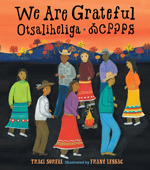 Otsaliheliga is the way Cherokee people say we are grateful as they celebrate and remember experiences through the year. Each double-page spread includes a phrase to complete a statement of gratitude. “When cool breezes blow and leaves fall we say ostsaliheliga . . .” Expressions on each page complete the statement, “. . . while we collect buckbrush and honey suckle to weave baskets / . . . to remember our ancestors who suffered hardship and loss on the Trail of Tears.” Lessac depicts the events and practices of the Cherokee in brightly colored gouache, folk art-style paintings in contemporary settings. Back matter includes a glossary, the Cherokee syllabary developed by Sequoyah, and an author’s note.
Otsaliheliga is the way Cherokee people say we are grateful as they celebrate and remember experiences through the year. Each double-page spread includes a phrase to complete a statement of gratitude. “When cool breezes blow and leaves fall we say ostsaliheliga . . .” Expressions on each page complete the statement, “. . . while we collect buckbrush and honey suckle to weave baskets / . . . to remember our ancestors who suffered hardship and loss on the Trail of Tears.” Lessac depicts the events and practices of the Cherokee in brightly colored gouache, folk art-style paintings in contemporary settings. Back matter includes a glossary, the Cherokee syllabary developed by Sequoyah, and an author’s note.
—SW
Ages 9–11
The Cardboard Kingdom. Chad Sell. 2018. Knopf/Random House.
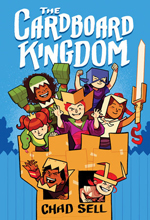 This graphic novel, a collaboration between cartoonist Chad Sell and 10 other creators,is a collection of short stories that showcase the imagination, creativity, and camaraderie of a group of children. During the summer, two children use cardboard boxes to create costumes and an imaginary world in a backyard. In the following stories, other children from the neighborhood transform themselves into royalty, superheroes, monsters, and other fantastic characters using cardboard and join in the imaginative play. One boy transforms himself into the Sorceress and a girl with a big voice becomes a roaring monster, the Big Banshee. The roles the 16 kids play in their Cardboard Kingdom give them the confidence to face real-life conflict with their families and to forge their identities. In the final chapter they celebrate their summer adventure at the Dragon’s Head Inn before starting off to school.
This graphic novel, a collaboration between cartoonist Chad Sell and 10 other creators,is a collection of short stories that showcase the imagination, creativity, and camaraderie of a group of children. During the summer, two children use cardboard boxes to create costumes and an imaginary world in a backyard. In the following stories, other children from the neighborhood transform themselves into royalty, superheroes, monsters, and other fantastic characters using cardboard and join in the imaginative play. One boy transforms himself into the Sorceress and a girl with a big voice becomes a roaring monster, the Big Banshee. The roles the 16 kids play in their Cardboard Kingdom give them the confidence to face real-life conflict with their families and to forge their identities. In the final chapter they celebrate their summer adventure at the Dragon’s Head Inn before starting off to school.
—JS
Counting on Katherine: How Katherine Johnson Saved Apollo 13. Helaine Becker. Ill. Dow Phumiruk. 2018. Christy Ottaviano/Henry Holt.
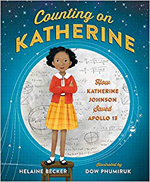 This picture book biography presents the life and work of trailblazing mathematician Katherine Johnson (1918–present). As a young girl, she loved numbers and counting, but segregation threatened to stymie her education. With the support of her family, she persevered in her love of discovering patterns in the universe through exploring numbers and solved mathematical problems. Katherine became a NASA researcher at the beginning of the space race in the 1950s. She was an important contributor to NASA programs, calculating flight paths for Apollo missions including the one that resulted in the safe return of the aborted Apollo 13 mission. Back matter includes additional information on Johnson’s life and a list of sources.
This picture book biography presents the life and work of trailblazing mathematician Katherine Johnson (1918–present). As a young girl, she loved numbers and counting, but segregation threatened to stymie her education. With the support of her family, she persevered in her love of discovering patterns in the universe through exploring numbers and solved mathematical problems. Katherine became a NASA researcher at the beginning of the space race in the 1950s. She was an important contributor to NASA programs, calculating flight paths for Apollo missions including the one that resulted in the safe return of the aborted Apollo 13 mission. Back matter includes additional information on Johnson’s life and a list of sources.
—MEO
Too Young to Escape: A Vietnamese Girl Waits to Be Reunited With Her Family. Van Ho & Marsha Forchuk Skrypuch. 2018. Pajama Press.
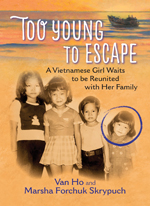 One morning in 1981, in Ho Chi Minh City, 4-year-old Van woke up to find her mother, sisters, and brother gone, following her father and older sister, who left a year earlier. They had fled the communist regime in South Vietnam after the Vietnam War by boat, leaving behind Van, who was too young, and her grandmother, who was too old, to make such a dangerous journey. With her grandmother, Van lived with her aunt and uncle, who treated her like an unwelcome servant, and she struggled with loneliness and poverty. Four years later, her parents, now living in Canada, brought Van and her grandmother to their new home. Back matter includes family photographs and an interview with Van’s parents that provide historical context for their leaving Van in Vietnam.
One morning in 1981, in Ho Chi Minh City, 4-year-old Van woke up to find her mother, sisters, and brother gone, following her father and older sister, who left a year earlier. They had fled the communist regime in South Vietnam after the Vietnam War by boat, leaving behind Van, who was too young, and her grandmother, who was too old, to make such a dangerous journey. With her grandmother, Van lived with her aunt and uncle, who treated her like an unwelcome servant, and she struggled with loneliness and poverty. Four years later, her parents, now living in Canada, brought Van and her grandmother to their new home. Back matter includes family photographs and an interview with Van’s parents that provide historical context for their leaving Van in Vietnam.
—JS
What Do You Do With a Voice Like That?: The Story of Extraordinary Congresswoman Barbara Jordan. Chris Barton. Ill. Ekua Holmes. 2018. Beach Lane/Simon & Schuster.
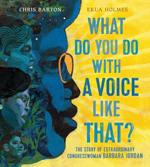 Growing up in Houston, Barbara Jordan (1936–1996) confidently used her strong voice. After graduating from law school at Boston University, she returned to Houston, began a career in law, and served as a Texas state senator. In 1972, she was elected to the U.S. Congress and eventually, became a professor at the University of Texas, where she continued to use her voice to speak for equality and justice. This biography of extraordinary Congresswoman Barbara Jordan, with stunning mixed-media collage illustrations, ends with an inspiring answer to the question posed in the title: “We remember it, and we honor it by making our own voices heard.” Back matter includes a detailed timeline, author’s note, references, and link to a bibliography.
Growing up in Houston, Barbara Jordan (1936–1996) confidently used her strong voice. After graduating from law school at Boston University, she returned to Houston, began a career in law, and served as a Texas state senator. In 1972, she was elected to the U.S. Congress and eventually, became a professor at the University of Texas, where she continued to use her voice to speak for equality and justice. This biography of extraordinary Congresswoman Barbara Jordan, with stunning mixed-media collage illustrations, ends with an inspiring answer to the question posed in the title: “We remember it, and we honor it by making our own voices heard.” Back matter includes a detailed timeline, author’s note, references, and link to a bibliography.
—MEO
Ages 12–14
Ghost Boys. Jewell Parker Rhodes. 2018. Little, Brown.
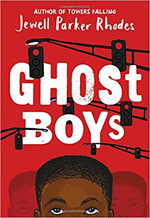 While playing with a toy gun, 12-year-old Jerome is fatally shot in the back by a white policeman. Returning as a ghost, Jerome observes the effects of his tragic death on his family, Sara (the policeman’s daughter, and Carlos (the friend who gave him the toy gun to fend off bullies) and discovers that he is surrounded by other ghost boys (including Emmet Till) killed in violent circumstances. Rhode’s work inspires important conversations about the complexities of blackness in America, conscious and unconscious bias, and privilege. Back matter includes an afterward, questions for discussion, and resources.
While playing with a toy gun, 12-year-old Jerome is fatally shot in the back by a white policeman. Returning as a ghost, Jerome observes the effects of his tragic death on his family, Sara (the policeman’s daughter, and Carlos (the friend who gave him the toy gun to fend off bullies) and discovers that he is surrounded by other ghost boys (including Emmet Till) killed in violent circumstances. Rhode’s work inspires important conversations about the complexities of blackness in America, conscious and unconscious bias, and privilege. Back matter includes an afterward, questions for discussion, and resources.
—MEO
Playing Atari with Saddam Hussein: Based on a True Story. Jennifer Roy (with Ali Fadhil). 2018. Houghton Mifflin.
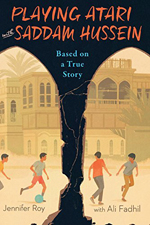 At the beginning of the Gulf War in 1991, Ali and his family, living in Basra, Iraq, have food, water, electricity, television, and video games. When all-night bombing starts, however, Ali, his father (a dentist), mother (a math teacher), and two brothers crowd into a safe room and sleep on the floor. As the war intensifies the family’s living conditions worsen, Ali’s father is deployed to the south to treat wounded soldiers, and, as Ali runs through the rubble of bombed neighborhoods to obtain his family’s government rations, he discovers the costs of war. Back matter includes an author’s note on the collaboration between the author and Ali Fadhil, on whose life the novel is based.
At the beginning of the Gulf War in 1991, Ali and his family, living in Basra, Iraq, have food, water, electricity, television, and video games. When all-night bombing starts, however, Ali, his father (a dentist), mother (a math teacher), and two brothers crowd into a safe room and sleep on the floor. As the war intensifies the family’s living conditions worsen, Ali’s father is deployed to the south to treat wounded soldiers, and, as Ali runs through the rubble of bombed neighborhoods to obtain his family’s government rations, he discovers the costs of war. Back matter includes an author’s note on the collaboration between the author and Ali Fadhil, on whose life the novel is based.
—SW
The War Outside. Monica Hesse. 2018. Little, Brown.
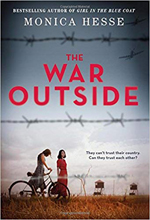 In 1943, Haruko, a Japanese American from Colorado, and Margot, a German American from Iowa, live with their families in Crystal City Internment Camp (located near Crystal City, Texas) during World War II for “enemy aliens,” people of Japanese, Italian, and German ancestry and their American-born children. In this novel told from alternative points of view, friendship grows between Haruko and Margot despite the prejudice and racism they experience as tensions increase, relationships become strained, and families face deportation or deal with the hard decision to return to countries now unfamiliar. Back matter includes an informative “Note on Historical Accuracy” by the author describing her research.
In 1943, Haruko, a Japanese American from Colorado, and Margot, a German American from Iowa, live with their families in Crystal City Internment Camp (located near Crystal City, Texas) during World War II for “enemy aliens,” people of Japanese, Italian, and German ancestry and their American-born children. In this novel told from alternative points of view, friendship grows between Haruko and Margot despite the prejudice and racism they experience as tensions increase, relationships become strained, and families face deportation or deal with the hard decision to return to countries now unfamiliar. Back matter includes an informative “Note on Historical Accuracy” by the author describing her research.
—SW
Age 15+
The Prince and the Dressmaker. Jen Wang. 2018. First Second/Roaring Brook.
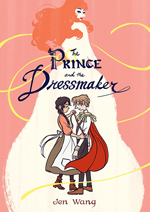 In this graphic novel, Frances is a talented dressmaker who dreams of fame as she creates elaborate dresses for her patron Prince Sebastian. He appreciates her unique gowns, which are beautifully displayed in the intricately detailed illustrations, and flaunts her designs in Paris nightlife as he adopts the persona of Lady Crystallia. Worried that his family will stop him from wearing Frances’ dresses, Prince Sebastian makes her promise to keep his true identity a secret. The graphic novel format conveys the growing complexity of this story of identity and friendship. To keep the prince’s secret safe, Frances must not take credit for her gowns and must remain anonymous, although she can’t keep silent forever if she wants her dream of being recognized as a fashion designer realized.
In this graphic novel, Frances is a talented dressmaker who dreams of fame as she creates elaborate dresses for her patron Prince Sebastian. He appreciates her unique gowns, which are beautifully displayed in the intricately detailed illustrations, and flaunts her designs in Paris nightlife as he adopts the persona of Lady Crystallia. Worried that his family will stop him from wearing Frances’ dresses, Prince Sebastian makes her promise to keep his true identity a secret. The graphic novel format conveys the growing complexity of this story of identity and friendship. To keep the prince’s secret safe, Frances must not take credit for her gowns and must remain anonymous, although she can’t keep silent forever if she wants her dream of being recognized as a fashion designer realized.
—MEO
The three reviewers are members of the 2019 Notable Books for a Global Society Committee. Sandip Wilson, cochair of the committee, serves as professor in the School of Education, Husson University, Bangor, Maine. Mary Ellen Oslick is an assistant professor in the Department of Education at Stetson University, DeLand, Florida. Junko Sakoi is program coordinator, Multicultural Curriculum Department, Tucson Unified School District, Arizona.